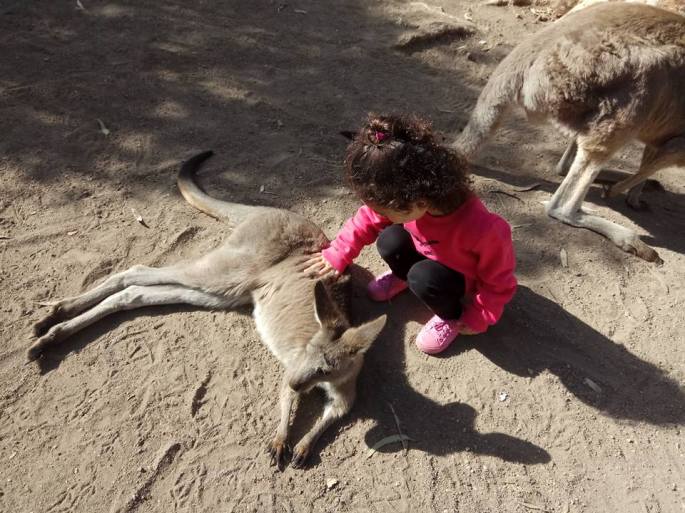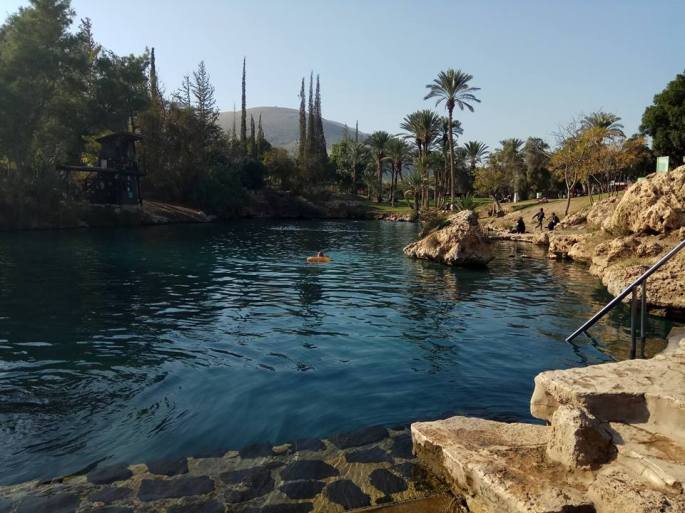
On Friday I visited two attractions just outside the town of Beit Shean. I almost didn’t get there, as unbeknownst to me, there was a marathon race going on and many of the roads were closed to traffic. Waze (the traffic and map navigation app) took me a roundabout way, telling me to go on dirt “security roads” that bordered kibbutz agricultural fields and Arab villages. Instead of taking an hour from my home, it took nearly 2.5 hours’ travel time and I got lost repeatedly! I finally passed a concrete bus stop where a soldier was waiting for a bus to take him home in time for Shabbat. I gave him a ride which he gratefully accepted all the way to his home on Kibbutz Nir David (where his mother anxiously and proudly awaited his return with all sorts of special treats and foods for Shabbat; I think every Israeli mother gives her son a hero’s welcome when he comes home on weekly leave). He had come all the way from south of Eilat, so this final leg of his long journey was a big relief to him, and he was of course a big help to me in finding my way.
The first place I stopped is called Gan Garoo (which is next to the aforementioned kibbutz). It’s an immaculately kept zoo that is dedicated to Australian-Israeli friendship, and all the animals within are those found in Australia. There are many different unusual birds large and small, but the real highlight is the “mob” of different varieties of kangaroos of all ages and sizes – some 53 in all – who roam freely in a large enclosure where humans can not only interact with them, but oblige the ‘roos with a much-appreciated back scratch or neck massage.


What a delightful experience! The kangaroos were as tame as one’s pet dog, and each one had its own look and personality. The joeys (baby kangaroos) were adorable, but my favorite was actually the oldest and largest, a red kangaroo with the expressive face of a donkey (others had faces that looked like rabbits, hares, deer and goats). They reacted equally well to being petted by a 3-year-old little girl as they did an adult human. It was truly thrilling, and I hated to leave, but on a short winter Friday, I wanted to leave time for a swim at the three spring-fed natural pools of Sachne (also known as Gan HaShlosha).


Sachne’s waters are a crystal-clear turquoise blue and maintain their 84 degree F temperature year round. The swimming there is fantastic. The springs, part of Israel’s national park system, are visited year round by an extremely diverse group of people: Israeli Jews (Sephardi, Ashkenazi, religious and secular, and lots of Russian, French, and Anglo immigrants) and Arabs (Christian and Muslim) families, along with a sprinkling of tourists, who are seeking an enjoyable, relaxing and beautiful way to spend the day. There is plenty of picnicking alongside the water in park-like grassy areas, and this is just one of many places where tolerance and cooperation between peoples defies the anti-Israel propaganda promoted by world media.


As the sun started to get lower, I regretfully said goodbye and continued on another 5 or 10 minutes by car to the town of Beit Shean, where I would be attending a special Shabbat weekend with other Anglo immigrants to Israel who are associated with Nefesh B’Nefesh, the organization that facilitates aliyah to Israel from North America, and provides many helpful services to help olim navigate the bureaucracy that challenges every newcomer. This annual gathering is specifically for olim (immigrants) who’ve chosen to make their permanent home in northern Israel (the Galilee and the Golan Heights). We stayed in a government-run youth hostel that was newly remodeled and expanded, with attractive if simple dorm-like rooms and a general dining hall where the dozens of Anglo immigrant families shared meals together. It was a great opportunity to meet and make new friends, and encourage one another with a deep understanding and empathy about the joys and challenges of living in Israel. Everyone was nice, but I was especially excited to meet some new potential friends and we have already made plans to get together next week.
On Saturday afternoon, the entire group meandered over to the Beit Shean archeological dig, which is located about a block away from the youth hostel. I was wondering why I had never visited the remnants of old Beit Shean and the subsequent Roman city of Scythopolis, which at one time housed a staggering 40,000 residents, when I lived in Israel many years ago! The beautiful amphitheater, which has been partially restored, had seats for 7,000 Roman citizens. You can wander down the Cardo (the shopping lane, lined with many stores), visit the arena where gladiator games were held; you can see the remains of a fountain, a temple, a brothel, and several restored mosaic floors. Perhaps most amazing, Scythopolis had only been aggressively excavated in the 1980s and 90s – – before that is was mostly unexcavated and buried completely under the ground (the city was completely destroyed by an earthquake in 749 AD) and the extent of its size until then was unknown – – which also explains why I hadn’t known about it when I lived in Israel in the early 80s and it was not yet open to the public.
Overlooking the ancient city, which was a half-way point for trade between Damascus and Caesarea, is a huge tel (mound) which was first excavated by archeologists from the University of Pennsylvania in the 1930s. Eighteen different civilizations were uncovered from the different strata, including Crusader, Muslim, Roman, Greek, Philistine, Israelite and Canaanite periods. The relics were shipped mostly to Philadelphia, where the University of Pennsylvania Museum of Archaeology and Anthropology was constructed especially to house the extensive finds (and is still in operation today). A small portion of the finds were donated to the Israel Museum where they can been viewed.
But for me the most meaningful events of Beit Shean occurred years before the Roman conquest. For it was at nearby Mt. Gilboa that King Shaul fought his final battle against the Philistine king. Three of Shaul’s sons were killed in that battle, and King Shaul himself was gravely injured. Rather than face capture alive, he threw himself upon his own sword, ending his own life. The Philistine king would not permit the corpses of Shaul nor his sons to be buried, and instead decapitated them and took their bodies to the gates of the city of Beit Shean, where they hung on those walls as a final humiliation.
It never fails to amaze me that I am walking on the very ground where my forefathers walked, lived, loved, prayed, fought, and died. Everywhere – everywhere! – in Israel, the ground is rich with the holy blood, sweat and tears of the Jewish people. I am not only reliving that history, I am part of it and it is part of me. The connection to the past is palpable, and the realization that I am part of its future fills me with humility and awe.
Only in Israel could I go from a modern Australian zoo to a natural oasis to an ancient city where Biblical battles were fought, all within a few minutes of one another.
Not a day goes by without me pinching myself that I merit living here on a daily basis, something my great-grandparents could only dream about in the most surreal of fantasies from their pogrom-ridden shtetls.
This new life of ours is very good indeed.
(I do not use a camera on Shabbat, which is why I didn’t take pictures of Beit Shean, the youth hostel, and the archeological park. Please feel free to click on the highlighted links for pictures taken by others.)

